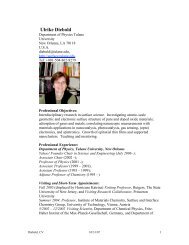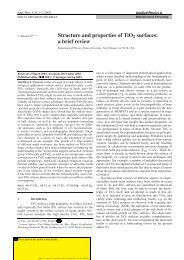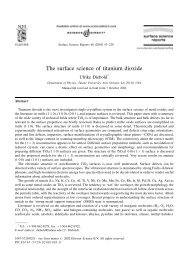Oxygen adsorption on Cu/ZnO (0001) –Zn - Diebold, Tulane
Oxygen adsorption on Cu/ZnO (0001) –Zn - Diebold, Tulane
Oxygen adsorption on Cu/ZnO (0001) –Zn - Diebold, Tulane
You also want an ePaper? Increase the reach of your titles
YUMPU automatically turns print PDFs into web optimized ePapers that Google loves.
Introducti<strong>on</strong><br />
The <strong>Cu</strong>/<strong>ZnO</strong> system has been extensively studied primarily because of its importance as a<br />
heterogeneous catalyst for methanol synthesis 1, 2, 3, 4, 5, 6, 7, 8 and the reverse water gas shift<br />
reacti<strong>on</strong> 6, 7, 8, 9 for hydrogen producti<strong>on</strong>. Furthermore, solid state gas sensors utilize the<br />
10, 11, 12<br />
<strong>Cu</strong>O/<strong>ZnO</strong> interface as the active element in humidity sensors and<br />
2<br />
also in the<br />
detecti<strong>on</strong> of harmful gases 12, 13, 14, 15 . In these sensors the fact that copper oxide is a p-<br />
type material, while <strong>ZnO</strong> is mostly an n-type <strong>on</strong>e, is important for their functi<strong>on</strong>ality.<br />
Band bending induced at the p-n juncti<strong>on</strong> reduces the c<strong>on</strong>ductivity of <strong>ZnO</strong>. Up<strong>on</strong> the<br />
reacti<strong>on</strong> of <strong>Cu</strong>O with a test gas, the magnitude of these band bendings are modified <strong>on</strong><br />
the <strong>ZnO</strong> substrate. This effect causes a modificati<strong>on</strong> of the c<strong>on</strong>ductivity, which can then<br />
be easily m<strong>on</strong>itored and used as the “gas resp<strong>on</strong>se” signal.<br />
For an improved understanding of the functi<strong>on</strong>ality of the <strong>Cu</strong>/<strong>ZnO</strong> system in device<br />
applicati<strong>on</strong>s as the <strong>on</strong>e described above, a better characterizati<strong>on</strong> of the <strong>Cu</strong>/<strong>ZnO</strong> interface<br />
is certainly desirable. In particular the dependence of the interface electr<strong>on</strong>ic structure <strong>on</strong><br />
the oxidati<strong>on</strong> state of copper is a relevant piece of informati<strong>on</strong>. To this end we performed<br />
X-ray photoelectr<strong>on</strong> spectroscopy (XPS) studies of <strong>Cu</strong>-deposits <strong>on</strong> a single crystal<br />
<strong>ZnO</strong>(<strong>0001</strong>) substrate under ultra high vacuum c<strong>on</strong>diti<strong>on</strong>s. Different oxidati<strong>on</strong> states of<br />
copper were prepared by using an oxygen- plasma source. The in-situ sample preparati<strong>on</strong><br />
and characterizati<strong>on</strong> procedure enables a detailed look <strong>on</strong> how the interface properties are<br />
altered by the interacti<strong>on</strong> with oxygen.<br />
Previous surface science studies of <strong>Cu</strong> depositi<strong>on</strong> <strong>on</strong> single crystal <strong>ZnO</strong> substrates are<br />
slightly c<strong>on</strong>troversial. One study showed the growth of <strong>Cu</strong> proceeds via a 2D mechanism<br />
up to a critical coverage of 33% of a m<strong>on</strong>olayer and then it c<strong>on</strong>verts into 3D cluster<br />
16, 17<br />
growth. Scanning<br />
tunneling microscopy (STM) studies, performed by members of<br />
our group, dem<strong>on</strong>strated instead the growth proceeds by the formati<strong>on</strong> 3D structures,<br />
already at very low <strong>Cu</strong>-coverage. 18<br />
It has been suggested, this discrepancy arises from<br />
the <strong>Cu</strong>-growth being very sensitive to the substrate preparati<strong>on</strong> and traces of<br />
c<strong>on</strong>taminants at the surface. These differences already hint that small amounts of<br />
adsorbed oxygen may play a role in the morphology of <strong>Cu</strong> clusters. Raim<strong>on</strong>di et al. have<br />
investigated the morphological changes induced by different (oxidizing) reacti<strong>on</strong><br />
c<strong>on</strong>diti<strong>on</strong>s <strong>on</strong> a model catalyst c<strong>on</strong>sisting of <strong>Cu</strong>-particles supported <strong>on</strong> a polycrystalline







